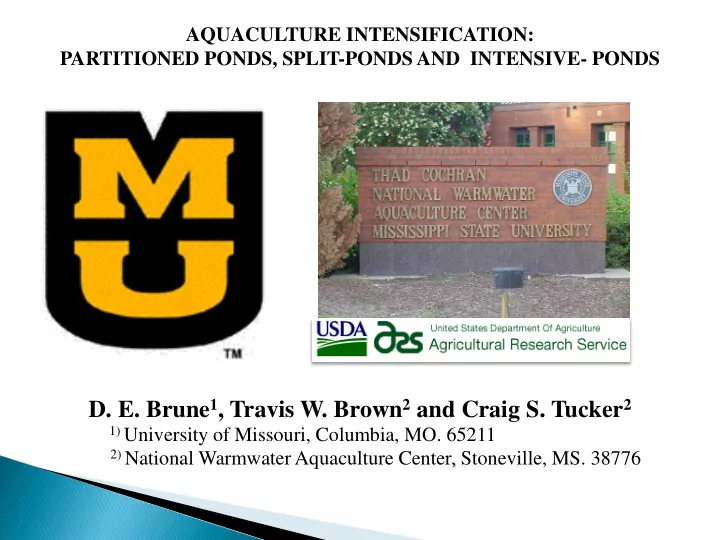

AQUACULTURE INTENSIFICATION: PARTITIONED PONDS, SPLIT-PONDS AND INTENSIVE- PONDS D. E. Brune 1 , Travis W. Brown 2 and Craig S. Tucker 2 1) University of Missouri, Columbia, MO. 65211 2) National Warmwater Aquaculture Center, Stoneville, MS. 38776
Development of the Partitioned Aquaculture System at Clemson University; 1987-2008 - Green-water for Catfish Production 25000 Max Catfish Carrying Capacity Catfish Net Production Tilapia co-culture for Tilapia Net Production 20000 management of algal production 15000 in a “High-Rate Pond” modified KG/HA for fish production, increasing 10000 carry capacity to 19,000 lb/acre 5000 0 1995 1996 1997 1998 1999 2000 2001
OBJECTIVES; 2014 &2015 Comparisons of Split-Ponds (SP) and Intensive Ponds (IP) at MS-State Delta Branch Experiment Station vs. Conventional Ponds (CP) and Partitioned Aquaculture Systems (PAS) for production of hybrid catfish ( Ictalurus punctatus x I. furcatus)
0.95 3.5 acres acres MS Split-Pond ; 2014 1995-2008 Clemson PAS ( 0.05-2.0 ac) 2014 MS Intensive Pond (2.0 ac)
MS Split Ponds and Intensive Ponds; 2015 IP-6W IP-5W SP-H4 SP-H3 3.8 ac 3.9 ac SP-H1 5. 5 ac 6.0 ft-deep 4.3 ft-deep Three 10-hp aerators IP-5E 3.9 ac Four 10-hp 1. 5 ac aerators 6 ft-deep
Mississippi Exp Station Split-Pond • Paddle • Oil hydraulic drive • Return channel
High-HP ponds; D-5 and D-6 • 1.93 acres water, 5.5 ft deep • 6 hp/acre aeration capacity
MS Split-Ponds; H-7 and #26 • 1 acre, 5-6 ft deep earthen fish culture pond (1.8 million gallons) • 3.5 acre 4-5 ft deep water treatment pond (averaging 6.7 million gallons) • Cross-levee canals, paddlewheel delivering 10,000-12,000 gpm flow yielding 4-6 fish zone water exchanges/12 hrs. • 6 hp/acre aeration capacity
Carrying Capacity and Feeding Type Max catfish Feed loading carrying capacity ave/max FCR (lbs/acre) (lbs/acre-day) lbs-feed/lbs-fish 1995-2008 PAS 15,000-18,000 160/250 1.4-1.6 CP 5,000-7,500 100/150 ~2.0 2014 SP 14,032 120/280 1.66 IP 18,245 107/270 1.75 2015 SP 12,800-14,100 110/216 1.9-2.0 IP 9,200-13,800 84/161 1.8-1.9
Measurements 2014 Daily; pH, temp, TAN, O2 profiles, light/dark bottles, Date Week with/without nitrification inhibitor, sedimentation 3/25/2015 1 rates, Seechi-disk 4/8/2015 3 4/21/2015 5 2014/2015 5/6/2015 7 5/20/2015 9 6/3/2015 11 Daily; feed application, energy consumption, in-situ 6/17/2015 13 7/1/2015 15 O 2 and temp controlling aerators and paddles 7/15/2015 17 7/29/2015 19 8/12/2015 21 8/26/2015 23 Every 14 days; pH, temp, TAN, NO 3 , NO 2 , alkalinity, 9/9/2015 25 9/23/2015 27 chl-a, total-N. algal and zooplankton identification 10/7/2015 29 10/21/2015 31 11/3/2015 33 and enumeration 11/18/2015 35 12/9/2015 37 Seasonal; fish yield and survival
Oxygen and Nitrogen Mass Balances Oxygen (lbs/acre-day) System Surface Fish Photosynthesis Deep Photo % of Fish Clemson PAS +72 -150 +180 -102 120 % Conventional Pond +40 -50 +32 -22 64 % MS Split Pond +40 -180 +140 -76 78 % MS High-HP Pond +80 -237 +157 -78 66 % Nitrogen (lbs/acre-day) System Feed Fish Photosynthesis Recycle Recycle % of Fish Clemson PAS +8.2 +6.2 -11.9 +5.8 93% Conventional Pond +2.2 +1.7 -2.2 +0.5 30% MS Split-Pond -5.8 +4.4 -8.7 +4.3 98% MS High-HP Pond +8.0 +6.0 -10.5 +4.5 75%
Water Treatment 4.3 ft, (72% of total volume) Fish Culture 6.0 ft, Photosynthesis; Top 30% (28% of total volume) Aerobic Treatment; Top 65% 12,000 gpm Anoxic Treatment; Variable15% 5 fish-zone exchanges/day Aeration = off Anaerobic Treatment; bottom 35%
Water Treatment 4.3 ft, 72% of total volume Fish Culture 6.0 ft, 28% of total volume Anaerobic ~ 100% Exchange = off Aeration capacity =30 hp/acre
Algal Removal Mechanism, Density and Dominant Algal Species Type Algal Density Algal removal Algal Algal cell Secchi Disk/TSS mechanism genera age (cm / mg/l) (apparent) (days) PAS 18 / 80 tilapia/sedimentation green 3.3 SP 13 /110 zooplankton/sedimentation bluegreen 1 4.6 IP 12 / 115 zooplankton/sedimentation bluegreen 1 3.8 CP 13 / 110 zooplankton/sedimentation bluegreen 2 9.0 1 Oscillatoria 2 Oscillatoria, Microcystsis Anabaena
Dominate Photosynthetic Organisms Split Pond vs. Intensive pond; 2015 Bluegreen dominance more sustained in Intensive-Pond vs. Split-Pond
PAS Bluegreen Biomass; 1999 (percent of total) % Bluegreen UNIT 3 100% 90% 80% % Bluegreen 70% 60% 50% 40% 30% 20% 10% 0% 6/3/99 6/17/99 7/1/99 7/15/99 7/29/99 8/12/99 8/26/99 9/9/99 9/23/99 10/7/9910/21/99 Date Tilapia filter-feeding (@25% of catfish biomass) reduces bluegreen dominance late season
Zooplankton and Algal Settling (2014) High algal settling rates in SP and IP Bluegreen algae enmeshed in detritus Large zooplankton populations High zooplankton numbers Rapidly settling algae
Partitioned Aquaculture System Continuous paddlewheel mixing, 100% aerobic, 3.0 hp/acre aeration 18,000 lb/acre in 5% of system (raceway culture), Rapidly growing green algae controlled by tilapia, few zooplankton 80 mg/l algal density, 25% algal respiration, No nitrification. Split-Pond Daytime mixing with paddle wheels, 80% anaerobic at night, 5.7 hp/acre aeration 12,800 - 14,100 lb/acre in 28% of system Rapidly growing bluegreen algae, rapid sedimentation, high zooplankton numbers 115 mg/l algae density, 50% algal respiration Nitrification = 20% of treatment More consistent algal bloom, lower bluegreen dominance vs. Intensive-Pond Lower capital cost compared to PAS
Intensive Pond Night-time mixing and aeration at 7.9 hp/acre, anaerobic % unknown 9,200-18,200 lb/acre in 100% of system volume Rapidly growing bluegreen algae, rapid sedimentation, high zooplankton numbers 110 mg/l algae density, 50% algal respiration, No nitrification Bird predation harder to control Lower capital cost compared to SP Conventional Pond Night-time mixing and aeration at 2.6 hp/acre, anaerobic % unknown 7,500 lb/acre in 100% of system volume Slowly growing bluegreen algae, sedimentation & zooplankton variable 110 mg/l algae density, 50% algal respiration, Nitrification unknown Lower capital cost compared to IP
Raceway culture with higher degree of control over algal population justify higher PAS cost ? Reduced cost of SP and IP given lower degree of control with bluegreen dominance justified? Is system behavior reproducible ? Reduced cost, lower production, and lower level of control of CP justified? Will variable algal dominance lead to off-flavor issues ? PAS control vs. CP low-cost: Systems-wide cost/lb vs. risk comparison ?
https://www.youtube.com/watch?v=AXlrf1dzpAY
Recommend
More recommend